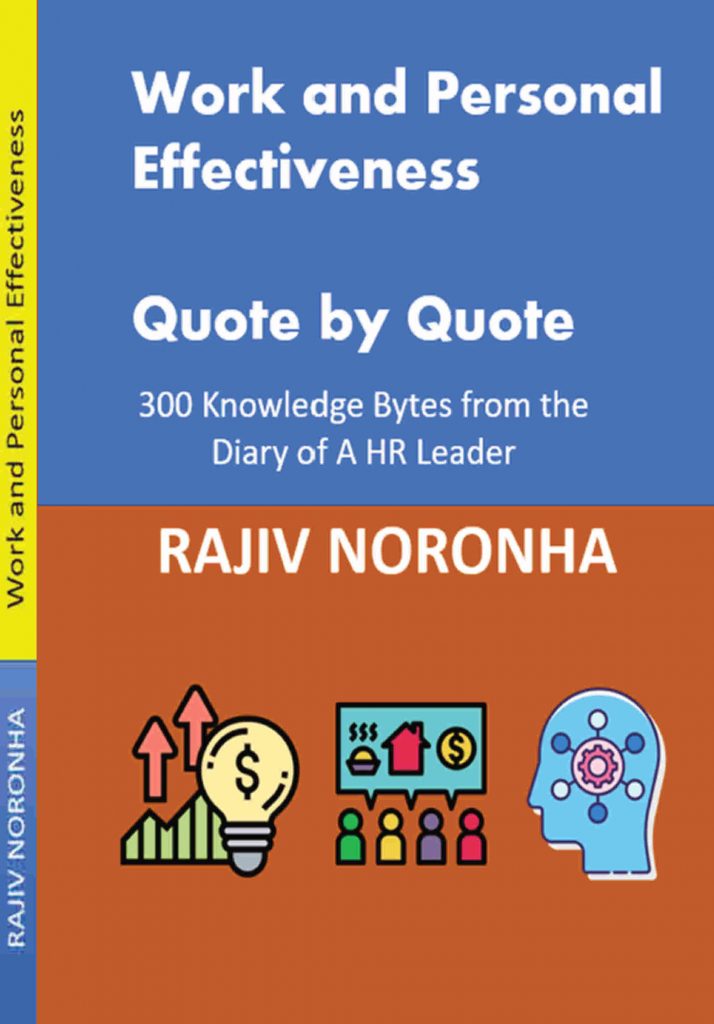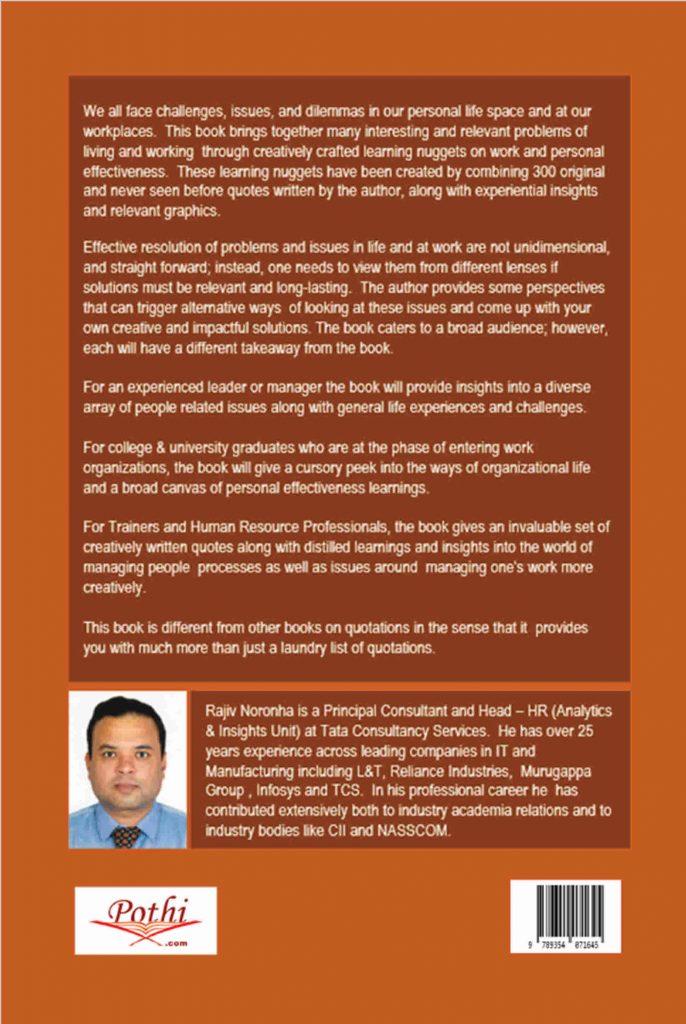
Authored by Mr. Rajiv Noronha (FPM 2003). Currently, he is a Principal Consultant and HR Head (Analytics & Insights Unit) at Tata Consultancy Services.
Synopsis: A book that distills various challenges, issues, and dilemmas we face in our work and personal life space, as a set of learning nuggets around work and personal effectiveness. The author uses 300 originally crafted quotations along with experiential insights and graphics to create these learning nuggets that are valuable resources for leaders, managers, and other individuals seeking effectiveness in their work and personal lives.
Distribution: In India- Digital version: www.amazon.in and Print Version: www.pothi.com, Other markets- print and digital versions through Amazon online Stores.
REVIEW BY MS HEMA RAVICHANDAR (PGP 1983), Strategic HR Advisor, and formerly SVP and Global Head of Human Resources for Infosys Limited.
We sit down to shape our thoughts into an article, prepare for a talk, get a message across to one of our recalcitrant team members, or even propose an alternate point of view to the boss. And wish and search – for just that impactful quote or motivational message that captures our sentiments and aptly drives home the point. Sounds familiar? Well, Rajiv Noronha has heard you and with his book “Work and Personal Effectiveness: Quote by Quote” steps in handily to help you in your search.
Of course, the book goes well beyond that. It has a larger purpose. It guides individuals on their journeys, both professional and personal, with practical wisdom and informational nuggets. Rajiv’s keen observations on everyday work, gleaned from his experience across multiple organizations, are helpful for all professionals in their quest for self-improvement. Indeed, his knowledge, learnings, and insights are all woven together beautifully into a collection that is both easy to read and relevant.
The book has an interesting structure. It is based on the premise that people are able to relate to concepts far better if they are illustrated through bite-sized anecdotes and snippets. Rajiv has cleverly used quotations throughout the book and has bundled them into areas of work effectiveness and personal effectiveness. To create easy access to nuggets of wisdom across a range of topics, they are further mapped across themes such as Talent Acquisition, Talent Development and Performance Management, for ‘work effectiveness’ and Developing Self and Managing Relationships for ‘personal effectiveness’.
The book has valuable insights for the HR professional and also for others, especially those in a supervisory role. The ‘Manager’s hat’ with its people management challenges may initially be quite daunting for many. The book, with its distilled information and relatable examples, would be a handy aide at this time. Trainers and coaches would also find it a useful go-to in their training programs and coaching journeys. And of course, each area can be easily accessed across the collection with the quote-map tables provided.
The book combines rhyme and reason in Rajiv’s inimitable style and makes for a refreshing read and a worthy addition to the library
REVIEW BY DR. S. JEYAVELU, FELLOW IIMA, and Dean, VIT-AP School of Business, VIT University.
Rajiv Noronha (FPM 2003; Dorm 17 and later FPM Houses) always had a knack of getting to the essence of the matter in any conversation. I remember his sharp, insightful, and witty observations having tea at the shop opposite the main gate of IIM A campus. Hence his book came as a matter of no surprises to me.
The book is in the form of nuggets – short insightful sentences, covering both personal and professional effectiveness categorized into various themes such as Career Management, Diversity, Leadership, Performance Management, Strategic Management, Talent Acquisition, Talent Development, Values & Ethics, Work Effectiveness, Developing Self, Managing Relationships and Personal Effectiveness.
Reading the book was like revisiting numerous conversations with colleagues, mentors, and friends. The book is packed with nuggets of wisdom that take the form of a story, poetry, or metaphor to nudge, surprise, or provoke the reader with insights.
Navigating the book took me on a self-reflective journey of my past experiences. There were moments when I encountered an all-encompassing image, distilling experience, and touching a raw nerve of doubts, idiosyncrasies, or consequences faced. The nuggets triggered refreshed memories of forgotten practices that worked, the unpalatable and unacknowledged underbelly, and aha moments of discovery of wisdom.
Listed below are six different perspectives that emerged as I read specific learning nuggets and quotes.
Preparing oneself with essential Knowledge, Facts, and Awareness: Quote #112 Gather data after analyzing the need, The supply gaps you will have to feed. Clear strategic priorities will sow the seed, And take you far in the journey, indeed.
Concerns that are usually kept locked away, such as failures and mistakes: Quote #190 Banishing failure to the gallow, will ensure that reluctance will follow.
Quote #206 The one who realizes and sets right the mistakes
Will be the most likely one to win at the stakes.
Prescriptions to the manager on managing oneself: Quote #180 Overcome the temptation to postpone; Successes will appear, cast in stone.
Quote #150 What gets focus gets attention; What gets attention gets done.
Performance orientation at work and our personal lives: Quotes #190 and #206 highlight the underbelly of performance orientation. Managers tend to avoid engaging with failures and mistakes. The way failures are managed, has established relationships with creativity, risk-taking, and effectiveness.
Mantra for any change program: Quote #16 Unity of Purpose, Diversity of Participation, and Commitment to Action are the Holy Trinity and Success Mantra for any change program.
This above quote captures the wisdom of change in three variables. This is not anecdotal; these three variables are empirically proven in change management and creativity research. Many organizational failures can be traced back to the lack of these variables. This nugget provides the depth and breadth of Rajiv’s experience and his integration of academic rigour with managerial practice.
Evoking powerful imagery in the minds of the readers: Quote #175 Employees are not racehorses who will gallop when the reins are pulled.
This nugget evokes an image of a horse struggling and yet running at top speed, while the rider is pulling the reins communicating STOP to the horse yet expecting it to gallop. This image highlights the struggle most leaders face in providing clear goals and necessary resources & support, and NOT hindering the output unknowingly. Easier said than done! The image of this horse will remain with me for a long time. Kudos to Rajiv for providing such powerful images for reflection throughout the book.
The most valuable aspect of this book is the integration of validated/accepted knowledge across fields, best practices from the professional manager’s world, and wisdom distilled from experience. It is likely to appeal to audiences with diverse learning preferences – those fond of stories, those who prefer theory & concepts, those who look for simple rules to follow, and to those who want distilled wisdom.
Apart from being a personal companion, this book will be a great gift to your friend, colleague, mentee, or boss – a coffee table book that will remain relevant for many many years. The references are a must-read for leaders.



